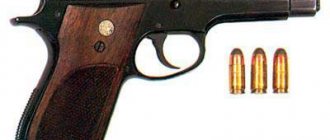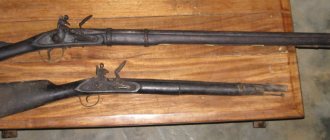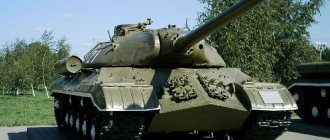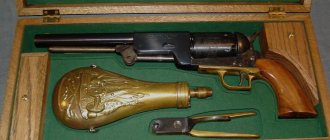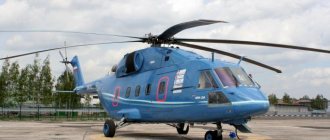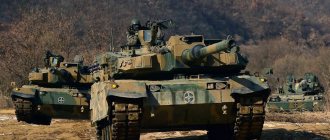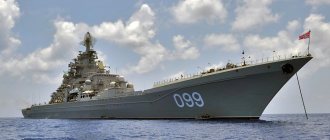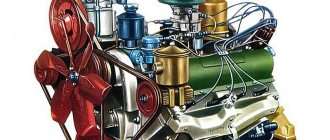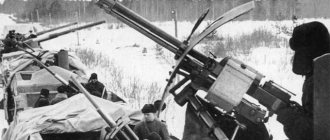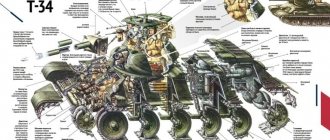Confrontation between projectile and armor
In the eternal competition between a projectile and armor, the latter inevitably loses sooner or later, and in the conditions of a world war, the process of creating more powerful weapons was especially fast. If at the beginning of the Great Patriotic War, Soviet heavy KV tanks were practically invulnerable to German tank guns and the anti-tank artillery models in service, then from 1942 the situation began to change quickly. Modernizing the KV tank could only give time, but did not solve the problem. As transitional options, the KV-85 and IS-1 tanks were created, armed with 85-mm cannons, capable in some cases of hitting heavy German equipment. However, in the second half of 1943, the same 85-mm guns were supposed to be installed on medium T-34/85 tanks, and the heavy tank was supposed to carry heavier weapons. With the rapid development of anti-tank weapons, the question of the armor of the future tank became acute.
Designer of heavy tanks Zh. Ya. Kotin. (warspot.ru)
Tests of captured German anti-tank guns have shown that it is almost impossible to create in a short time, in the conditions of a difficult war, a fundamentally new heavy tank capable of withstanding constantly improving weapons. And there was only one way out - to rely on the mass production of tanks with powerful weapons capable of fighting both heavy equipment and enemy manpower. Therefore, it was decided to take the IS-1 tank as the base version, strengthening its armament, increasing armor protection as much as possible, and most importantly, achieving high production technology. All these tasks had to be solved in an extremely short time frame.
This is how the IS-2 tank appeared, which was officially put into service on October 31, 1943. The serial IS-2 had the following characteristics: weight 46 tons, maximum speed 37 km/h. Armor protection reached 120 mm. The tank received a 122 mm D-25T cannon. The machine gun armament consisted of three DT machine guns. Since 1944, some tanks received as additional weapons a large-caliber anti-aircraft machine gun DShK, designed to destroy low-flying air targets, and in street combat conditions - to fight enemy infantry. The crew consisted of four people. The armor weight has tripled compared to the KV. Cast components and parts were used as much as possible, accounting for up to 45% of the structure.
At the origins of the new generation of heavy tanks
In Soviet tank building of the pre-war and war periods, three main waves of designers can be traced. The first wave occurred in the first half of the 20s, when tanks were under the control of artillery, and design personnel came from artillery and tractor manufacturing.
These include, first of all, the team of the Technical Bureau of the State Administration for Internal Affairs - S.P. Shukalov, V.I. Zaslavsky, N.V. Tseits and others. At the end of the 20s, designers of the second wave began to appear, often graduating from specialized universities and entering tank building consciously. A classic example of a designer of the second wave is S. A. Ginzburg.
The second wave also included such venerable Soviet tank builders as N.A. Astrov, N.V. Barykov, N.L. Dukhov, N.A. Kucherenko, A.A. Morozov and M.I. Koshkin. As for Shashmurin, he became one of many representatives of the third wave design school.
Despite the fact that some of the representatives of the third wave graduated from universities in the first half of the 30s, their active work on tanks began already in the second half of the decade. It was this galaxy of engineers that became the driving force that raised Soviet heavy tanks to a qualitatively new level.
N. F. Shashmurin (marked with a cross) during his internship in the 1st Mechanized Brigade named after. Kalinovsky, 1931.
© warspot.ru
Most of those who later formed the backbone of SKB-2 of the Kirov plant were not born in Leningrad. In the case of Nikolai Fedorovich, the situation was different. He came from a family of hereditary miners from the Urals. His father Fyodor Ivanovich had only two years of education, but at the same time he was well-read and strived for knowledge all his life.
The stormy beginning of the 20th century directly influenced Fyodor Ivanovich. He took part in the Russo-Japanese War, and by the will of fate he ended up in St. Petersburg, where he settled. On June 26, 1910, his son Nikolai was born. Fyodor Ivanovich also took part in the First World War, during which he repeatedly received awards, and was also shell-shocked and gassed.
By 1917, he became a Bolshevik, participated in revolutionary events, taught military affairs to the Red Guards, and later repeatedly served as a deputy of the Petrosovet and Lensovet. At the same time, Fyodor Ivanovich understood perfectly well that his son needed to be given a good education. This is how Nikolai Shashmurin ended up in Soviet labor school No. 4, which in fact was nothing more than “Petrishule” - one of the oldest educational institutions in St. Petersburg, founded back in 1709. Despite the revolutionary events, the former “Petrishule” still retained a core of professors, and Nikolai received an excellent education.
“Torsion” suspension, Shashmurin’s debut in SKB-2. She became the subject of the first conflict with Kotin.
© warspot.ru
Nikolai Fedorovich studied for a long time. Following his primary and secondary education, he proceeded to pursue higher education. The place of study was the Leningrad Polytechnic Institute named after M.I. Kalinin (LPI), which in 1930 was divided into several universities. Shashmurin ended up at the Leningrad Institute of Mechanization of Socialist Agriculture. Officially, tractor building training took place here, but in fact, personnel for tank-building enterprises were also trained.
Nikolai Fedorovich also became interested in tank building. In addition to the theoretical part, students underwent practical training - for example, in the 1st mechanized brigade named after. Kalinovsky. So Shashmurin had a good idea of what tanks were. After graduating from the institute, LBTKUKS (Leningrad Armored Advanced Training Courses for Command Staff of the Red Army) followed. Thus, by June 1937, when Nikolai Fedorovich Shashmurin entered SKB-2 of the Kirov plant, he had a large amount of knowledge, which he almost immediately began to implement.
T-28 with Shashmurin torsion bar suspension during testing. They showed the advantages of a torsion bar suspension over a locked one.
© warspot.ru
The second half of the 30s became an extremely difficult time for Soviet tank building. This also applied to the Kirov plant. The T-28 production program was disrupted for a number of reasons, and a wave of repression swept through the plant. O.I. Ivanov, head of SKB-2, was repressed. In his place in April 1937, J. Ya. Kotin was appointed, who had previously worked at the VAMM named after. Stalin, where he supervised a number of works, including an airborne landing system for amphibious reconnaissance tanks. SKB-2 unsuccessfully tried to finalize the T-29, which was supposed to be the successor to the T-28.
Just in the midst of work on the modernization of the T-29, Shashmurin entered the position of design engineer. The new version of the vehicle was called T-29CN and was already a full-fledged breakthrough tank with rational plate angles and frontal armor 50 mm thick. The combat weight increased to 32 tons, so the issue of suspension was very acute. It was at this moment that information came from Sweden that the new Landsverk L-60 tank had a “torsion” (that’s what it was called in the message) suspension. The development of a domestic version of the torsion bar suspension was Shashmurin’s first task. However, the final version of the T-29CN still had a spark plug suspension - to be on the safe side, Kotin chose more conservative solutions.
SMK in the version with torsion bar suspension. In this form, the tank went into operation, at the same time becoming the source of the confrontation between Shashmurin and Kotin, which lasted 40 years.
© warspot.ru
The T-29TsN never went beyond the drawing documentation, but in 1938 work began on a new breakthrough tank, the SMK-1. When it was created, SKB-2 under the leadership of Kotin initially focused on a locked suspension, descending from the T-35. Nevertheless, Shashmurin was still able to insist on his version with torsion bars. It must be said that Kotin had his own reasons for installing a locked suspension.
The fact is that the SMK-1 with a locked suspension had a mass of 55 tons, and with a torsion bar - 57 tons. There were also production reasons. And yet, the torsion bar suspension was more promising, and the full travel of the roller was greater - 303 millimeters versus 210-230. At the beginning of 1939, a prototype torsion bar suspension was tested on the T-28, after which it was finally made the standard SMK-1 suspension.
All this was preceded by a fierce struggle between Kotin and Shashmurin. Subsequently, all this resulted in a confrontation that lasted for decades. Suffice it to say that Shashmurin was never awarded for SMK-1.
KV U-0, it also used Shashmurin’s torsion bar suspension. The first car of Nikolai Fedorovich, which went into mass production.
© warspot.ru
Next, work began on the project of the “halves” of the SMK-1, as the KV heavy tank can be called. Work on it began by decision of the Main Supreme Council of December 9, 1938. The development was carried out by fifth-year VAMM students S. M. Kasavin, B. P. Pavlov, L. N. Pereverzev, V. K. Sinozersky, G. A. Turchaninov and L. Shpuntov - in fact, they were implementing their diploma project, dated October 1938.
Initially, Shashmurin was made the project manager (it was believed that the priority was QMS), but in February 1939, when a preliminary version of the KV project was prepared (Shashmurin himself called it “Kotin - Voroshilov”), management of work on the machine passed to L. N. Dukhov . Shashmurin developed a manual gearbox for the KV, then this gearbox was replaced with the one developed according to Dukhov’s project.
Against this background, Shashmurin developed hostility: he often accused Dukhov of creating an unreliable checkpoint, which ultimately destroyed the KV in its original form. One way or another, the KV received Shashmurin’s torsion bar suspension, and on December 19, 1939, the tank was accepted into service with the Red Army. Subsequently, Shashmurin’s torsion bar suspension was installed on all Soviet heavy tanks and self-propelled guns.
Five-speed gearbox that Shashmurin developed for the T-220.
© warspot.ru
Starting with the HF, one of the main areas of Shashmurin’s work at SKB-2 was the development of gearboxes. At the same time, he also participated in the creation of the K-1 light tank project, which later formed the basis for the T-50 developed by the Kirov plant.
In the second half of 1940, work began on the T-220 heavy tank. For him, Shashmurin developed a new five-speed gearbox. The development turned out to be very useful, since the combat weight of the T-220 was more than 62 tons, and the power of the V-2SN engine was 850 hp. With. The tank turned out to be unreliable, so breakdowns plagued it with enviable regularity, but there were no problems with the gearbox. It is no coincidence that this particular gearbox was going to be used on the T-222 - this was the name of the improved version of the T-150 tank, which, in turn, was supposed to go into production as the KV-3.
A similar gearbox was supposed to be installed on the KV-3.
© warspot.ru
The same gearbox was planned for another tank with the KV-3 index, the development of which began in the spring of 1941. The gearbox diagram for the T-50 LKZ was designed using the same scheme. Shashmurin’s most specific work was the KV-4 heavy tank. At first, this machine was supposed to have a mass of about 72 tons, but it quickly became clear that it would not fit into it. A competition was held at the Kirov plant, where almost all the people from SKB-2 were involved, including Shashmurin. This idea belonged to Zh. Ya. Kotin, he was supported by the director of the Kirov plant I. M. Zaltsman. Shashmurin himself reacted extremely negatively to this competition, but participated in it. Later he recalled his KV-4:
Having received, along with other leading employees of the design bureau, the task of developing a project for such a cyclops, but certainly a multi-tower one, I, not sharing the proper optimism regarding the last condition (multi-tower - how long ago did we abandon the “Mur-Meriliz” included in the QMS), made a “move” horse." In general, he abandoned the turret installations and repeated what he had done on the KV-1 tank when installing the M-10 howitzer of 152 mm caliber, that is, a caponier (cutting) superstructure on the armored hull. And since a new, almost super-heavy tank KV-3 had already been created, I decided not to overthink it with a supernew tank. Having thrown off the turret, he repeated the previous version as a high-power self-propelled gun, installing a 107 mm Grabin cannon there. Indicating in the explanatory note that under certain conditions the gun can be removed, and instead of it, a rifle squad of infantrymen can be placed in the fighting compartment. This option was not allowed into the competition because the conditions were not met - higher protection, tank weight of 80-100 tons, turret (multi-turret) weapon installation. To avoid unnecessary confrontation, I compromised. Considering that a super-heavyweight cannot be a tank, having adopted the specified protection, he invested in a weight of about 90 tons, retained the caponier installation of the main gun, and installed a serial turret of the KV-1 tank on the roof of the lowered cabin. It ended with I.M. Zaltsman really liking this option (taking into account its “reasonable,” as he put it, universality), and I received a second prize in the amount of 1000 rubles. This is cool. I bought a fur coat for my wife with this money.
92-ton KV-4, the heaviest of Shashmurin’s projects. He himself called him “B.” S.”, that is, “the ravings of a madman.”
© warspot.ru
In fact, Shashmurin’s project did not even take third place. The first place went to Dukhov's project (5,000 rubles), which was put into work, the second place went to the project of Kuzmin, Mitskevich and Tarotko (3,000 rubles), the third went to Zeitz, and Ermolaev and Sychev received an equal prize (2,000 rubles). Shashmurin was awarded a prize of 1,500 rubles. He himself called the KV-4 and the subsequent KV-5 nothing less than “B. WITH." (abbreviated “ramblings of a madman”). Very close to the truth, since even the KV-3 was a very dubious idea, but here we were talking about monsters weighing 85-100 tons. They were not destined to be realized - the Great Patriotic War began, which changed the lives of millions of Soviet citizens, including Shashmurin.
Production of IS-2: problems and solutions
The main enterprise where it was planned to launch production of the IS-2 was the Kirov plant, which was evacuated to the Urals at the beginning of the war. Very difficult work lay ahead to prepare the plant for the development of a new combat vehicle, refurbishment of old workshops and even construction of new ones. It was assumed that from December 1943 to April 1944 a monthly production level of 300 units could be achieved. But already in March 1944 the plan was increased to 500 heavy tanks per month.
IS-2 in Prague, May 1945 (war-book.ru)
In both cases, the Kirov Plant coped with the planned tasks, but the quality of the first IS-2s turned out to be extremely low. As a result, at the beginning of February 1944, the People's Commissar of the Tank Industry V.A. Malyshev banned the development of new tank models at the Kirov Plant, and devoted all efforts to eliminating the design and technological shortcomings of the IS-2. The designer of heavy tanks and at the same time the deputy people's commissar of the tank industry, Joseph Yakovlevich Kotin, was appointed chief designer of the plant until production was fully mastered. Special groups were created that were supposed to carry out daily monitoring of the quality of production of the IS-2 and self-propelled guns based on them. There was no immediate improvement in quality - only in the third quarter of 1944 did the quality of the tanks produced improve significantly. During the work, 39% of the project documentation was adjusted - and in total 7,800 various changes were made. In general, the development of the complex production process was completed by the end of 1944. The total number of IS-2s, including the post-war production of IS-2s, reached 3.5 thousand units.
Stirlitz had two tanks - he rode them in turns. The queue was indignant, but did not disperse
Photo World
4.1K posts 5.1K subscribers
Community Rules
We behave decently, no politics, just photos, you can take your own photos, interesting photos, etc.
Muller enters his office and sees Stirlitz rummaging through his safe with secret documents.
— Trams don't run here.
Muller left the office to smoke and think about the current situation. And when he returned, Stirlitz was not in the office.
Stirlitz went out into the clearing and saw blue spruce trees. Taking a closer look, Stirlitz realized that the blue ones not only ate, but also drank.
Combat use of the IS-2: strengths and weaknesses of the tank
IS-2 tanks entered service with individual guards tank regiments (21 tanks) and individual heavy tank brigades (65 IS-2s). The IS-2 received the D-25T cannon as its main armament. This weapon was created on the basis of the A-19 field gun. The choice of this weapon determined a number of strengths and weaknesses of the IS-2. The D-25T had a very long firing range and powerful high-explosive fragmentation shells, indispensable in the fight against enemy firing points and in overcoming powerful, pre-prepared defenses.
By the time the IS-2 appeared at the front, the Red Army was conducting mainly offensive operations, and the 122-mm IS-2 gun turned out to be very useful for breaking through the defense. IS-2s were successfully used to break through German defenses, for example, near Konigsberg and Berlin. Later, in August 1945, the IS-2 successfully demonstrated itself during the Soviet-Japanese War in Manchuria. However, the weapon also had a number of disadvantages. The low rate of fire (1-2 rounds per minute) versus 4-6 for the Tigers and Panthers made the IS-2 very vulnerable in a tank duel. The ammunition itself, consisting of 28 separate-loading shells, was also almost three times less than that of German tanks.
IS-2 at the May Day parade in Minsk, 1948 (odetievbrony.ru)
On the other hand, battles between heavy tanks were relatively rare, usually fought at direct shot range, when armor protection could no longer save either the IS-2 or the Tiger, and everything depended on the competent use and training of the crews. Marshal of the Armored Forces M.E. Katukov in his memoirs cites an episode when in April 1944, to destroy the “tigers” that were acting up in the area of his army, he allocated two IS-2s, which destroyed heavy German tanks from an ambush. In street battles, where tanks are especially vulnerable, a lot depended on competent interaction with infantry - where this interaction was disrupted, tank units suffered serious losses.
In the post-war period, the IS-2 remained in service with the Soviet and Russian armies for a very long time (until 1993). In the 1950s, the tank underwent major modernization. Nowadays, the IS-2 can often be found in museum collections; many heavy tanks are also installed as memorials.
History of creation
History of creation
Dedicated to those burned alive in tanks...
IS-2 tank from the 7th Guards Heavy Tank Brigade at the Brandenburg Gate. Berlin, May 1945.
Without exaggeration, it can be said that the IS-2 heavy tank traces its ancestry to the KV-1 and KV-13 tanks: the first tank is quite well known; about the second, until now it was possible to glean information, sometimes contradictory, only from two or three publications devoted to the history of SKB-2 of the Kirov plant. Therefore, it is necessary to talk about this combat vehicle in more detail.
The KV-13 (object 233) became the first major independent work of the Experimental Tank Plant, created in March 1942 in Chelyabinsk on the basis of SKB-2. N.V. Tseits, who had just been released from prison, was appointed as the lead designer of the project. The design team also included K.I. Kuzmin (hull), N.M. Sinev (tower), S.V. Mitskevich (chassis) and G.N. Moskvin (general layout). The KV-13 was created within the framework of the idea of a universal tank, corresponding in weight to a medium tank and in protection to a heavy one. A feature of the project was the widespread use of armor casting. Not only the turret was cast, but also the main elements of the hull - the bow, turret box, and hull rear block. This made it possible to reduce internal unused volumes, differentiate armor protection and ultimately reduce the need for armor plates. The last circumstance was very important, especially in light of the order of the State Defense Committee of February 23, 1942, which ordered to save armored steel in every possible way.
The first prototype of the vehicle was designed and manufactured in an extremely short time, and in May 1942 it entered factory testing. The mass of the tank was 31.7 tons. Armament was a 76-mm ZIS-5 cannon and a coaxial DT machine gun. The thickness of the frontal armor of the hull reached 120 mm, and the thickness of the turret - 85 mm. Engine V-2K with a maximum power of 600 hp. allowed to reach speeds of up to 55 km/h. The chassis elements, including the caterpillar, were taken from the T-34, and the road wheels were borrowed from the KV. On the KV-13, an improved horseshoe-shaped radiator was used, similar to that previously installed on the T-50 light tank (a variant of the Kirov plant), which made it possible to arrange the engine compartment more tightly and significantly increase the utilization rate of the air pumped by the fan. The original design of the nine-speed gearbox with a triple range was installed coaxially with planetary final drives.
Tests of the first KV-13 sample revealed a number of shortcomings - the difficulty of ensuring the acceleration characteristics of the gearbox, the destruction of the road wheels and chassis tracks, the tracks falling off when turning, etc. 8, in the midst of testing in July 1942, N.V. Tseits suddenly died, and N.F. was appointed lead designer of the vehicle. Shashmurin. On his initiative, the KV-13 was equipped with a gearbox developed by F.A. Marishkin for the KV-1s, and chassis components from this tank. However, even in this form the tank did not withstand testing, after which the customer’s interest in it noticeably decreased. Despite this, the Experimental Tank Plant began assembling, albeit rather sluggishly, two new versions of the KV-13 tank in December 1942.
All that was borrowed from the first sample for these machines was the body, torsion bar suspension and five-wheel chassis. The towers and many other units were redesigned. A special feature of the transmission was two-stage planetary rotation mechanisms developed by A.I. Blagonravov. The cooling system was improved; only units from the KV-1s tank were used in the tracked propulsion system, while the track chain was made lighter through the use of odd ridgeless tracks.
Combat vehicles of the Experimental Tank Plant. From top to bottom: KV-13 (object 233), IS-1 and IS-2 (object 234).
The most direct impact on the pace of production of these vehicles was the appearance of new German heavy Tiger tanks in the fall and winter of 1942-1943 on the Soviet-German front. GKO Decree No. 2943ss of February 24, 1943 ordered the Chelyabinsk Kirov Plant and Plant No. 100 NKTP (as the Experimental Tank Plant became known by this time) to produce and submit for state testing two prototypes of the Joseph Stalin tanks - IS. The latest versions of the KV-13 were taken as the starting point for them. At the same time, the first, armed with a 76-mm ZIS-5 cannon, received the designation IS-1, while the second, with a 122-mm U-11 tank howitzer in the turret, borrowed from the experimental KV-9 heavy tank, received the designation IS-2 ( object 234).
Tests of both vehicles were carried out from March 22 to April 19, 1943 and were generally successful. The commission recognized that, as a result of a denser layout than the KV-1s, the IS tanks, with a lower weight, have stronger armor and a higher speed with weapons equivalent to them in the IS-1 and more powerful in the IS-2. However, they noted and serious defects, mainly in the engine transmission unit and chassis. On soft ground, the tanks experienced great resistance to movement due to the deflection of the caterpillar links into the inter-roller space - greater than that of the KV-1s. The commission recommended providing for an increase in the number of road wheels on the next IS samples.
In parallel with the tests at ChKZ, at plant No. 100 and the main related enterprises - UZTM and plant No. 200 - preparations for mass production of new combat vehicles were in full swing. But subsequent events forced some very significant adjustments to be made. At the beginning of April, reliable data was received on the armor protection of the Tiger, and already on April 15, GKO decree No. 3187ss was issued, which obligated the People's Commissariat of Armaments to create powerful tank guns capable of fighting the enemy's new equipment.
From top to bottom: object 237 (IS No. 1) in the courtyard of plant No. 100; object 238 - preserved to this day in the Armored Vehicles Museum in Kubinka: object 239 after shelling tests.
At the end of April, at the NIIBT Test Site in Kubinka, near Moscow, the only captured Tiger was shot from various artillery systems. As a result, it turned out that the most effective means of combating it was the 85-mm anti-aircraft gun 52-K model 1939, which penetrated its 100-mm armor from a distance of up to 1000 m. GKO Decree No. 3289ss of May 5, 1943 “On strengthening the artillery armament of tanks and self-propelled guns” oriented design bureaus towards the ballistics of this gun. In accordance with this decree, the Central Artillery Design Bureau - TsAKB (head - V.G. Grabin) and the Design Bureau of Plant No. 9 (chief designer F.F. Petrov) were ordered to develop and install two experimental IS 85- tanks on two KV-1Si tanks mm guns with the ballistics of a 52-K anti-aircraft gun.
In the first half of June, all four guns - two S-31 TsAKB and two D-5T from plant No. 9 - were ready. The S-31 was developed by placing an 85-mm barrel on the cradle of a 76-mm serial ZIS-5 tank gun, which could significantly facilitate its production. As for the D-5T, it was a variant of the D-5S cannon, developed for the SU-85 self-propelled artillery mount, and was distinguished by its low weight and short recoil length.
Already during the preliminary studies of the layout of the IS tank with an 85-mm cannon, it became clear that with a clear turret ring diameter of 1,535 mm, it was not possible to install such a gun without a sharp deterioration in the working conditions of the crew. Therefore, they decided to expand the shoulder strap to 1800 mm by increasing the volume of the fighting compartment and, accordingly, the length of the tank by 420 mm. Since the length of the hull between the second and third road wheels has increased significantly, a sixth road wheel had to be added to the chassis of the tank (on each side). A new turret was cast at Plant No. 200 to accommodate the increased diameter of the shoulder strap. All these changes led to an increase in the tank's weight to 44 tons, a decrease in specific power and a deterioration in dynamic characteristics. This was the price for more powerful weapons. The tank with an 85-mm cannon was designated object 237. Two experimental ISs, No. 1 with the S-31 gun and No. 2 with the D-5T, were ready at the beginning of July 1943.
Simultaneously with the work on object 237, ChKZ also produced two preliminary designs for installing an 85-mm cannon on the KV-1s tank. The first option - object 238 - was a serial KV-1S with an S-31 cannon in a standard turret, the second - object 239 - received a turret from object 237 with a D-5T cannon.
In July 1943, comparative tests of all four tanks took place. Based on the results obtained, preference was given to the D-5T cannon and objects 237 and 239, which from that moment began to be called IS-85 and KV-85, respectively. Due to the extreme cramped conditions of the fighting compartment and the inability of the crew to work normally in it, object 238 was rejected.
Object 237 (IS No. 1) fords a water obstacle during factory tests.
IS-1
Object 237 (IS No. 2) during field testing.
On July 31, KV-85 and IS-85 tanks arrived at the NIIBT Test Site in Kubinka to undergo state testing. The equipment was accompanied by 28 specialists, led by the chief engineer of the plant. yes No. 100 N.M. Sinev. The tests began on August 2 and were carried out by a commission chaired by the head of the Technical Directorate of the GBTU of the Red Army, Major General S.A. Afonin. Artillery tests took place at the Gorokhovets artillery range. Based on their results, the commission recommended both models for adoption. Then the tanks were placed at the Cherkizovo station in the workshops of the evacuated plant No. 37. On August 8, a column of experimental combat vehicles passed through the streets of Moscow to the Kremlin, where they were inspected by Stalin, Molotov, Voroshilov, Beria, Fedorenko, Malyshev and others. It is interesting to note that before the show All crew members were removed from the vehicles (with the exception of the driver mechanics), replacing them with NKVD officers.
On September 4, 1943, by decree of the State Defense Committee No. 4043ss, the heavy tank IS-85 was adopted by the Red Army. By the EIIM decree, Experimental Plant No. 100 was obliged to design, manufacture and test, together with the Technical Directorate of the GBTU, by October 15, 1943, an IS tank armed with a 122 mm caliber cannon, and by November 1, an IS-152 artillery self-propelled gun based on it.
From the above it follows that, contrary to the version widely spread in the literature, the IS-2 tank with a 122-mm cannon and the ISU-152 artillery self-propelled gun were not demonstrated to Stalin during the above-mentioned display. For IS-2, apparently, the authors took IS No. 2 (that is, armed with a D-5T cannon) and the SU-152 (KV-14) self-propelled gun, but with an improved ventilation system for the fighting compartment.
It is worth noting that the state commission has developed a number of proposals to improve the design of the IS tank, some of which are clearly influenced by foreign experience. The latter include proposals to design and test a hydraulic mechanism for turning the turret and a turret anti-aircraft machine gun installation on the hatch of the commander's cupola, and to develop an installation in the turret of a breech-loading 50 mm mortar for self-defense and launching signal flares. It was also proposed to design a cradle suitable for mounting 85-, 100-, 122- and 152-mm guns.
The first idea of arming the IS with a gun of a larger caliber than 85 mm was expressed by the director and chief designer of Plant No. 100 Zh.Ya. Kotin. At the beginning of August 1943, while studying the results of the Battle of Kursk, he drew attention to the fact that of all the artillery systems, the 122-mm hull brigade gun was the most successful in fighting the Tigers. 1931/37 (A-19). The designers of Plant No. 9 came to the same conclusion, where a prototype of the D-2 heavy anti-tank gun was developed and manufactured by superimposing a barrel with the ballistics of the A-19 gun on the carriage of a 122-mm M-30 divisional howitzer. This powerful weapon was intended to be used primarily to combat enemy heavy tanks. But as soon as the barrel of such a gun was mounted in the cradle and the M-30 carriage and the D 2 gun was successfully tested, the idea of installing the barrel of an A-19 e heavy tank using a round cradle, recoil devices and a lifting mechanism from an experienced 122-mm tank became real. U-11 howitzers, as was done when creating the 85-mm D-5T and D-5S guns. True, it was possible only if a muzzle brake was introduced into the design of the gun.
Heavy tank IS-85 in the factory yard.
Having received the necessary documentation from Plant No. 100, the design bureau of Plant No. 9 quickly completed a preliminary design for the layout of the A-19 in the turret of the IS-85 tank, which Zh.Ya. Kotin took to Moscow. People's Commissar of the Tank Industry V.A. Malyshev really liked it and was approved by I.V. Stalin. By GKO Decree No. 4479ss of October 31, 1943, the IS tank with a 122-mm cannon was adopted by the Red Army. At the same time, Plant No. 9 was ordered to produce a tank version of the A-19 gun with a piston bolt by November 11, 1943 and present it for firing tests by November 27. At the same time, it was ordered to equip this gun with a wedge breech and begin its production in 1944. The production of prototypes of 100-mm cannons for arming the IS tank was also permitted.
The first sample of the A-19 tank gun was made on November 12 - the D-2 gun barrel, removed from the M-30 carriage, was installed in the D-5T cradle, with additional turning of its guide part to the diameter of the cradle; The T-shaped muzzle brake was also borrowed from the D-2 gun.
State tests of the IS-122 tank (object 240) passed very quickly and, in general, successfully. After which he was transferred to one of the training grounds near Moscow, where a shot was fired from a 122-mm cannon from a distance of 1500 m in the presence of K.E. Voroshilov at an empty, already shot captured German Panther tank. The shell, having pierced the side armor of the turret turned to the right, hit the opposite sheet, tore it off at the weld and threw it several meters away. During the test, the T-shaped muzzle brake of the A-19 gun was torn, and Voroshilov almost died. After this, the muzzle brake was replaced with another - a double-chamber, German type.
The first production IS-85 tanks were manufactured in October 1943, and the IS-122 in December. In parallel with the assembly of ISs in the ChKZ workshops, the production of KV-85 tanks continued until the end of the year. In January 1944, the last 40 IS-85s left the ChKZ workshops, after which only IS-122s came out of its gates in ever-increasing numbers, equipped with the new 122-mm D-25T gun with a wedge semi-automatic breech, due to which it was possible to slightly increase the rate of fire (from 1 - 1.5 to 1.5 - 2 rounds/min). Since March 1944, the German type muzzle brake was replaced by a more effective one - the TsAKB design. From that time on, the IS-85 tanks were renamed IS-1, and the IS-122 tanks were renamed IS-2.
IS-2 early release
Production of heavy tanks IS-1 and IS-2
| date | IS-1 | IS-2 |
| 1943 | ||
| October | 2 | — |
| november | 25 | — |
| December | 40 | 35 |
| Total: | 67 | 35 |
| 1944 | ||
| January | 40 | 35 |
| February | — | 75 |
| March | — | 100 |
| April | — | 150 |
| May | — | 175 |
| JUNE | — | 200 |
| July | — | 225 |
| August | — | 250 |
| September | — | 250 |
| October | — | 250 |
| november | — | 250 |
| December | — | 250 |
| Total : | 40 | 2210 |
| 1945 | ||
| until 9.05. | — | 997 |
| after 9.05. | — | 1150 |
| Total: | — | 2147 |
| Total: | 107 | 43S2 |
However, the issue of arming the IS-2 tank was not completely closed. The military was not satisfied with either the low rate of fire or the small ammunition load - 28 rounds of separate loading - of the new heavy tank. For comparison: the IS-1's ammunition consisted of 59 rounds, and the KV-1S's - 114. In addition, after the first collisions of the IS-2 with heavy enemy tanks, it became clear that the standard 122-mm sharp-headed armor-piercing projectile BR-471 was capable of penetrating the frontal the Panther's armor only from a distance of 600 - 700 m. The weaker frontal armor of the Tiger was hit from a distance of 1200 m, but only well-trained, experienced gunners could hit a German tank from such a distance. When shelling German tanks with powerful OF-471 high-explosive fragmentation grenades, the IS-2 experienced cracking of welds and even tearing off of the front welding plate. The first results of their combat use, confirmed, by the way, by firing tests of the tank at the Kubinka training ground in January 1944, forced the designers to look for new solutions.
On December 27, 1943, State Defense Committee decree Ns 4851 was issued on arming the IS tank with high-power guns, and in February 1944, the design of three vehicles began - IS-3, IS-4 and IS-5 (not to be confused with the post-war tanks of the same name).
The IS-3 tank (object 244) was an IS-1 tank with a high-power D-5T-85BM cannon installed instead of a standard gun with an initial projectile speed of 900 m/s. The installation of the gun did not entail any alterations, since all installation dimensions remained the same. At facility 244, a new breakable telescopic sight PT-8 was tested, as well as a number of experimental engine and transmission components, in particular, synchronizers for 3rd - 4th and 7th - 8th gears, which made it possible to reduce the time for switching them and made it easier to control the vehicle. Tests of the 244 continued until the end of March 1944 and ended in failure due to insufficient strength of the gun barrel.
Heavy tank IS-122 (object 240). Above: in the courtyard of plant No. 100; below: during field testing, November 1943.
The IS-4 and IS-5 tanks are better known by their original designation IS-100. The GKO decision provided for the production of only one tank, armed with a 100-mm S-34 TsAKB gun with the ballistics of a B-34 naval gun. However, the installation of such a gun required rearranging the fighting compartment and casting a new turret, which neither tank builders nor the military liked very much. At this moment, the Design Bureau of Plant No. 9 offered its 100-mm cannon for the IS. Like the 85-mm D-5T, the new gun, designated D-10T, was developed on the basis of a self-propelled gun of the same caliber. Unlike the S-34, it was installed in a standard turret without any special modifications. From March 12 to April 6, 1944, the IS-4 tank (object 245) underwent state testing, which it failed and was returned to the factory to refine the semi-automatic gun and some other elements. As a result, the tank was equipped with a D-10T cannon with a new semi-automatic system, a more powerful fan for the fighting compartment, the slope of the ammunition rack in the turret niche was changed, etc. The gun had an initial projectile speed of 900 m/s. The ammunition included 30 unitary rounds with armor-piercing and high-explosive fragmentation shells weighing 15.6 kg.
The S-34 gun arrived from plant No. 92 to plant No. 100 not on February 20, as planned, but only at the beginning of April 1944. The production of the new tower was also delayed. Unlike its competitor, the IS-5 had an inverted mask mount, due to the need to place the gunner on the right. The commander's cupola with the tank commander's workplace was also moved to the right side of the turret. The loader in this vehicle was located to the left of the gun. In addition to the three crew members, it was also planned to place a mechanical rammer in the turret, and subsequently install a sight stabilizer. As a result of all these improvements, the IS-5 heavy tank (object 248) was manufactured by Plant No. 100 only in June 1944.
From July 1 to July 6, joint tests of the IS-4 and IS-5 tanks took place at the Gorokhovets training ground, during which the military rejected the first and proposed modifying the second. By October, the IS-5 turret had a rammer and a sight stabilized in the vertical plane. Ammunition was increased to 39 rounds. The commander's position was moved even further to the starboard side, so that the breech of the gun, which rolled back during shots, could not hit him. Tests confirmed the significantly increased combat qualities of the tank. In terms of rate of fire, it was significantly superior to all known heavy tanks; it had no equal in terms of armor penetration of shells and accuracy of firing on the move. However, the deployment of mass production of a heavy tank with a 100 mm gun was considered inappropriate. Artillery designers were asked to develop a new projectile with greater armor penetration for the 122-mm D-25T cannon. Such a projectile, an armor-piercing blunt-headed projectile with a ballistic tip BR-471B, appeared in the spring of 1945, but began to enter the ammunition loads of heavy tanks almost after the war.
Options for muzzle brakes of the D-25T gun
T-shaped
German type
TsAKB designs
Above: experimental tank IS-3 (object 244); below: IS-5 tank (object 248).
However, since the fall of 1944, the question of increasing the armor penetration of shells disappeared by itself. The D-25T cannon suddenly began to perfectly hit German tanks. In reports from units, there were descriptions of cases when a 122-mm BR-471 projectile, fired from a distance of more than 2500 m, ricocheted off the frontal armor of the Panther, leaving huge holes in it. This was explained by the fact that since the summer of 1944, the Germans, due to an acute shortage of manganese, began to use high-carbon armor alloyed with nickel and characterized by increased fragility, especially in places of welds.
The first combat clashes with enemy tanks also revealed insufficient armoring of the frontal part of the IS hull. At the beginning of 1944, they tried to increase the armor resistance of the hull by hardening it to a very high hardness, but in practice this led to a sharp increase in hull parts. When an IS tank manufactured in March 1944 was fired at a training ground from a 76-mm ZIS-Z cannon from a distance of 500 - 600 m, its armor was broken from all sides, and the bulk of the armor-piercing shells did not penetrate the armor, but caused the formation of large masses of secondary fragments. This fact also largely explains the significant losses of the IS-85 and IS-122 tanks in the battles of the winter and spring of 1944.
In February 1944, TsNII-48 received the task of conducting research on the topic “Study of the armor resistance of the IS heavy tank hull.” The work carried out showed that with the existing shape of the frontal part of the hull, it will be guaranteed against penetration by German 75- and 88-mm shells only if armor with a thickness of at least 145-150 mm is used (that is, 20-30 mm more than standard). On the recommendation of TsNII-48, the hardening modes were changed, as well as the design of the frontal part of the hull.
The new hull, with the so-called “straightened” nose, retained the same armor thickness. The driver's hatch plug was removed from the front plate, which significantly reduced its strength. The sheet itself was positioned at an angle of 60° to the vertical, which ensured that at firing angles of ±30° it would not be penetrated by the 88-mm German KwK 36 tank gun, even when fired at point-blank range. The weak point remained the lower frontal sheet, which had an angle of inclination of 30° to the vertical. To give it a greater angle of inclination, a significant change in the design of the control compartment was required. However, given that the probability of hitting the lower frontal plate is less than other parts of the hull, they decided not to touch it. In order to enhance the armor protection of the lower frontal plate, from July 15, 1944, they began to place spare tracks on it between the towing hooks. Uralmashzavod switched to producing armored hulls with a “straightened” welded nose in May 1944, and Plant No. 200 began producing the same hulls, but with a cast nose, in June 1944. However, for some time tanks with old and new hulls were produced in parallel, until the stock was completely used up.
IS-2 early production of 1944.
Characteristic details attract attention: a cast frontal part with a “broken” nose and a driver’s hatch; a narrow embrasure of the gun and an armored cap of the PT4-17 periscope sight in front of the commander's cupola.
Armor penetration of 122 mm shells*
| Range, m | 500 | 1000 | 2000 |
| BR-471 | 150/122 | 138/113 | 118/96 |
| BR-471B | 157/128 | 147/120 | 129/105 |
* The numerator indicates the thickness of the armor being penetrated at an impact angle of 90°, and the denominator indicates the thickness of the armor being penetrated at an impact angle of 60°.
Options for the bow of the IS-2 tank hull
The original "broken" cast
With a “straightened” nose, cast from ChKZ
With a “straightened” nose, welded, produced by UZTM
As for the turret, it was not possible to significantly enhance its armor protection. Designed for an 85 mm gun, it was statically fully balanced. After installing the 122-mm gun, the moment of imbalance reached 1000 kg/m. In addition, the terms of reference suggested increasing the frontal armor to 130 mm, which would lead to even greater imbalance and would require the introduction of a new rotation mechanism. Since it was impossible to carry out these measures without radically changing the design of the tower, they had to be abandoned.
However, during the production process the appearance of the tower changed significantly. The turrets of the tanks of the first series produced in 1943 had a narrow embrasure. After installing the D-25T cannon, despite the fact that its cradle was the same as that of the D-5T, using the telescopic sight became very inconvenient. In May 1944, the production of turrets with an expanded embrasure began, which made it possible to shift the sight to the left. The armor protection of the mask installation and the thickness of the lower part of the sides were also increased. The commander's cupola was shifted to the left by 63 mm, the PT4-17 periscope sight was removed, and an MK-IV surveillance device was installed in its place. An anti-aircraft installation of a DShK heavy machine gun (designed by P.P. Isakov) appeared on the commander’s cupola. Until the end of the war, the IS tower did not undergo any other significant changes.
In addition to modernizing the tank during serial production, ChKZ and plant No. 100 were designing new promising models in accordance with the tactical and technical requirements developed at the GBTU at the end of 1943. In this regard, it is worth noting the project of a heavy tank under the code name IS-2M, developed under the leadership of N.F. Shashmurin in the spring of 1944. The layout of this machine was unusual. The fighting compartment, turret and transmission were located in the rear of the tank, the engine compartment in the middle, and the control compartment in the front. The chassis used large-diameter support rollers without support rollers. The transmission of torque from the engine to the transmission was carried out using a driveshaft running under the floor of the fighting compartment. The location of the turret at the rear of the hull prevented the long-barreled gun from sticking into the ground and made it easier to maneuver the tank in narrow passages. Since at the beginning of the summer of 1944, the design bureau of plant No. 100 began designing two versions of the IS-6 heavy tank (objects 252 and 253), work on the IS-2M was stopped.
IS-2 late production of 1944 with a modified hull nose and an expanded gun embrasure.
IS-2 late production 1944.
It should be noted that large-diameter stamped support rollers, intended for the chassis of object 252, were tested on experimental object 244, loaded with cast iron pigs to the required weight.
On August 5, 1944, for special services in the creation of new models of heavy IS tanks and self-propelled artillery units, Plant No. 100 was awarded the Order of Lenin. In turn, for its services in organizing the production of new types of tanks, self-propelled guns and tank diesel engines and equipping the Red Army with them, the Chelyabinsk Kirov Plant was awarded the Order of the Red Star. In February 1946, for outstanding achievements in the creation of new models of armored vehicles, J.-Y. Kotin, A.S. Ermolaev, G.N. Moskvin, N.F. Shashmurin, G.I. Rybin, A.S. Shneideman , E.P. Dedov and K.N. Ilyin became laureates of the Stalin Prize.
In 1945, production of the IS-2 tank was completed. By the way, 10 combat vehicles were manufactured in Leningrad in the restored workshops of the Leningrad Kirov Plant.
The IS-2 remained in service with the Soviet Army in the post-war years. The IS-3 (object 703) planned to replace it had significant design flaws that made it difficult to operate the tank among the troops. And they produced relatively few of them, discontinuing production in 1946. The IS-4 heavy tank (object 701) also turned out to be difficult to operate and maintain. At the same time, the IS-2 was quite suitable for the army as a technically reliable and easy-to-use combat vehicle. Therefore, the GBTU decided, starting in 1957, to carry out structural improvements to these tanks during major overhauls in order to extend their service life, as well as unify a number of components and assemblies with components and assemblies of other heavy tanks [Separate modernization measures were carried out on IS-2 tanks starting since 1954, in particular, strengthening the bottom under the gearbox by welding an armor lining with a thickness of 16 - 20 mm.].
Subsequently, the IS-2 was equipped with a V-54K-IS engine with an electric starter, a NIKS-1 nozzle heater, an MZN-2 electric oil pump and a VTI-2 air cleaner with dust extraction from the hoppers. Installation of a new engine entailed changes to the lubrication and cooling systems. External fuel tanks were included in the tank's power system in the same way as on the IS-3 tank. A gearbox with an oil pump and an oil cooling system was installed, and it was rigidly mounted on the rear support. Planetary turning mechanisms began to be connected to the supporting disks of final drives using a semi-rigid connection. New track rollers and idler wheels with non-adjustable bearings were installed in the chassis.
In the assembly shop of the Chelyabinsk Kirov plant, 1944.
IS-2M, used as a target at one of the training grounds in the 1970s. Noteworthy is the non-standard gun with an ejector in the middle part of the barrel. The muzzle brake is screwed on.
The changes to the body affected mainly the engine-transmission compartment, in which a reinforced sub-engine pedestal and new gearbox mounts were installed. In addition, the driver's slit observation device was replaced with a prismatic observation device borrowed from the T-54, the tank was equipped with an “Angle” device and a TVN-2 or BVN night vision device.
A new reinforced stopper, similar to the type used on the T-54 medium tank, was installed in the turret, as well as a gun lifting mechanism with a release link. The ammunition load was increased to 35 artillery rounds. The rear turret machine gun was removed and an additional fan was installed in its place. The hole in the turret for the machine gun was welded with a special armor plug, in which there was a labyrinthine slot for ventilation.
The number of batteries was increased from two to four. They installed R-113 radios and R-120 tank intercoms of post-war design, new wings with IS-3 type bunkers that played the role of anti-cumulative screens, electric fuses and electric discharges for BDSh smoke bombs, a second headlight with a blackout device, and changed the composition and layout of spare parts.
At the same time, during the overhaul of tanks, a number of technological improvements were carried out: double bakeliting of tanks and pipelines, increasing the resistance of anti-corrosion coatings, restoring the seats of parts to nominal sizes, etc.
As a result of modernization, the combat and technical characteristics of the IS-2 tank changed, and it received the designation IS-2M. It should be noted that modernization began in 1957 and ended in the mid-60s, therefore, depending on the time of overhaul, IS-2M tanks sometimes differed significantly from each other both in the nature of the changes made and in the units used. The entire fleet of heavy IS-2 tanks of the Soviet Army was brought to the level of IS-2M, as a result of which there were practically none left in their original form 8 USSR.
Shepherd dog of the Saga Dakhmarda breed, named Polvon in the mountains of Tajikistan
We continue the topic of shepherd dogs and now let’s turn to places where life and herding of sheep is impossible without such dogs. For example, the mountains of Tajikistan
This is where dogs live who do not know chains and kennels. Meet Polvon, this handsome working shepherd dog Polvon.
He is in his favorite mountains, with his owners. Take a closer look at him
At first glance it seems small.
But he has something to answer to local predators; his teeth are very serious.
But he is not dangerous to his own people. He listens to his owners unquestioningly, and it is important. Will they be adults or teenagers?
To home dog lovers, he may seem thin and underfed. But this is not so. This is a working dog, he is practically not fed in the summer, he must hunt gophers himself. marmots and mice. At the same time, Polvon does not refuse a treat. Let it be simple bread.
Of course, only after the owners’ permission is he ready to take treats from strangers.
This is a good protector of the herd and people from predators. By the way, closer to autumn it will grow fur. because in the mountains there are very harsh winters and you need to somehow protect yourself from frost and wind.
Technical characteristics of IS-1
| Combat weight, t | 44 |
| Travel speed, km/h | 40 |
| Armament | 1x85mm D5-T85, 3x7.62 mm DT |
| Cruising range, km | 150 |
| Crew, people | 4 |
| State | accepted into service in 1943 |
| Developer | KB ChKZ |
| Manufacturer | CHKZ |
| Production | small series 1943 |
| Length, mm | – with gun forward – 8560 – hull – 6770 |
| Width, mm | 3070 |
| Tower roof height, mm | 2735 |
| Ground clearance, mm | 465 |
| Wed. beat ground pressure, kg/cm2 | 0.78 |
| Obstacles to be overcome | – rise, deg. – 36 – ford, m – 1.3 |
| engine's type | diesel V-2-10 (V-2-IS) |
| Maximum power, hp | 520 |
| Fuel capacity, l | 500+360 |
| Specific power, hp/t | 11,8 |
| Maximum speed, km/h | 40 |
| Cruising range, km | 150 |
| Reservation, mm | – hull forehead – 120 – turret forehead – 100 |
| Means of setting smoke curtain | 2 dsh |
| Aim | 10T-15, PT-4-15 |
| Radio station | 10-RK-26 |
